BIG BLUE FANS FOR

BASKETBALL
2013-14 Season Analytical Writings
01
Who Are The Nation's Top Programs
Heading Into The 2013-14 Season?
In the 1990s, there was little doubt that Rick Pitino's Kentucky Wildcats were a legitimate part of the national championship conversation. Pitino returned the program to the front of that national stage in his third season. Pitino revived the program from the shame that it had become in the aftermath of the Emery Air Package fiasco. Pitino led the Cats to an Elite 8 before losing in OT to repeat National Champion Duke, and then three final fours in five years, including a national championship and a national runner up also decided in Overtime. Arguably, the National Championship that followed Pitino's exit from UK following the 1997 Runner Up finish is largely to Pitino's credit, much more so than Tubby Smith's.
Then the dark years set in on this program. Kentucky experienced its longest Final Four drought in program history as Tubby Smith brought the program down from the pinnacle to the quicksand of mediocrity. Billy Gillispie did little to restore the program to the championship conversation before the Kentucky brain trust ran him out of town on a rail. The dark ages of UK basketball ran from 1999 through 2009.
Then, along came John Calipari, who reaffirmed in his first year that while some casual fans, and some members of the media may have forgotten about the UK program, the program's strong foundation sustained it and was instrumental in the program's quick revival. The missing ingredient was imply proper leadership at the head coaching position. Pitino showed the world this truth about the Kentucky program in the early 1990s. Calipari demonstrated this truth in 2010, with a team built largely on highly touted freshmen who would have traversed the March Madness to a Final Four if they had not stumbled in an Elite 8 shootout against West Virginia. However, Calipari's second group, again led by outstanding freshmen, did not stumble on their trip to the final four in 2011.
Kentucky fans will forever remember the 12 long years after the last "Pitino" championship to its next appearance in a Final Four. However, the resurgence of the program was not quite finished until Calipari shed the huge Gorilla from his personal coaching back in 2012 by completing his first championship, and delivering the Big Blue Nation its 8th overall.
The Cats are back. Calipari and the program remain in the forefront of the current national championship conversation.
What other programs have a legitimate claim to a seat at this most exclusive table in 2013 as the sport prepares for its 2013-14 season? The record over the last 18 years provides a large part of the answer, but the true icons of the sport have established histories and traditions that span multiple decades, back to the 60s, 50s, and even into the 40s. Consider:
• The last 11 Champions have averaged an Adjusted NGE for their season of 0.346 points per possession,
• Nine of the 11 champions crossed the 0.30 ppp threshold,which represents the rare air of championship quality play.
• Only 52 teams combined have finished a season with an Adjusted NGE of 0.30 ppp or higher during the previously 11 seasons. That threshold defines the top tier of teams in any individual season.
• Not a single champion finished with an Adjusted NGE below 0.25 ppp.
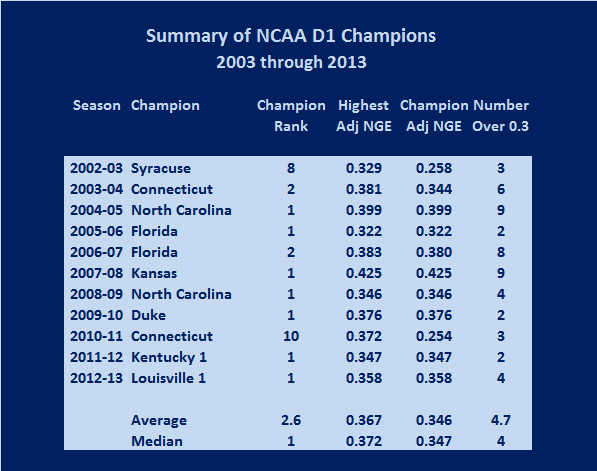
Any program that can sustain its play in a majority of seasons at a performance level of 0.25 ppp or higher is in an elite class. In a particular season, any team that can sustain its play at a performance level of 0.30 ppp or higher is elite for that season.
Based on my review, in the summer of 2013, there are ten programs that satisfy this criteria over the last 10 seasons: Duke, Florida, Louisville, Kansas, Kentucky, Michigan State, North Carolina, Ohio State, Syracuse, and UConn (listed alphabetically). These ten programs have finished five or more of the last 10 seasons at 0.25 ppp or higher 5 or more times. These ten programs have won the last 11 championships, and 16 of the last 18 championships. These teams have defined basketball excellence for the current generation. These 10 programs form the nucleus of my list. However, for reasons of history, tradition, and current trends, I remove UConn from the final list and add Indiana. Others will have their lists.
In addition to UConn, other prominent basketball programs do not make my 2013 list of elites. Most notably absent is UCLA. However, they lack the true history and tradition required to earn the elite status. The UCLA heyday occurred in a 12-year span, 1964 through 1975, during which UCLA captured 10 of the 12 National Championships. They have added one more Championship to their total since 1975, but overall, UCLA has not been a significant factor on the national scene since 1975.
Over the years since the 1940s when college basketball was getting established to the present, a handful of programs have been prominent in nearly every decade. That list of programs with sustained history and tradition includes Kentucky, North Carolina, Kansas, Duke, Ohio State, Michigan State, and Indiana. These programs' history and tradition, coupled with current trends speak more toward their inclusion and UCLA's exclusion. In addition to UCLA and UConn, my list excludes other notables including former Champions Maryland, and Arizona. For similar reasons, my list does not include media darling Gonzaga.
My top 10 programs as of the summer of 2013 are Duke, Florida, Indiana, Kansas, Kentucky, Louisville, Michigan State, North Carolina, Ohio State, and Syracuse, in alphabetical order. My conclusions are analytically based, by examining the trends for these and other programs over the last 10 seasons (2004 through 2013) and projecting the state of the program using these trends at the beginning onf 2014. The basis of comparison is the Adjusted Net Game Efficiency, all taken from data published by Ken Pomeroy, http://kenpom.com .
Since I know I am writing to a group whose primary, and sometimes solitary interest is Kentucky basketball, I want to illustrate the trend presentation for Adjusted NGE for the Cats. Then I will go through the remainder of the top 10 programs in alphabetical order.
KENTUCKY:
Kentucky:
Kentucky's tradition and history spans the 40s, 50s, 60s, 70s, 80s, 90s, and into the century. The 8 National Championships is second only to UCLA's 11, but the Kentucky Championships occurred in the 40s, 50s, 70s, 90s, and the new century. As noted previously, the Wildcats claim three titles over the last 18 years, but between 1998 and 2010, the program fell into a pattern of mediocrity, from which it is clearly rebounded back into national prominence. The Cats' have only exceeded the 0.30 ppp Adjusted NGE threshold twice in the last decade, but both of those occurred in the last 4 years, since Calipari's arrival in Lexington. Kentucky's spot on the elite list is traditional, historical, and supported by recent performance trends.

DUKE:
Duke, under Coach K's leadership spanning the 1980s to the present, have nearly become synonymous with excellence in college basketball. However, Duke's success in this sport pre-dates Coach K's arrival, extending into the 60s with Coach Bubas. Over the last 18 years, Duke has claimed 2 more National Championships, and in the last 10 years has consistently performed with adjusted Net Game Efficiencies at or above the 0.30 threshold of greatness 5 times. Furthermore, their trend for Adjusted NGE appears stable. These factors demand that Duke belongs on the Elite Program List. 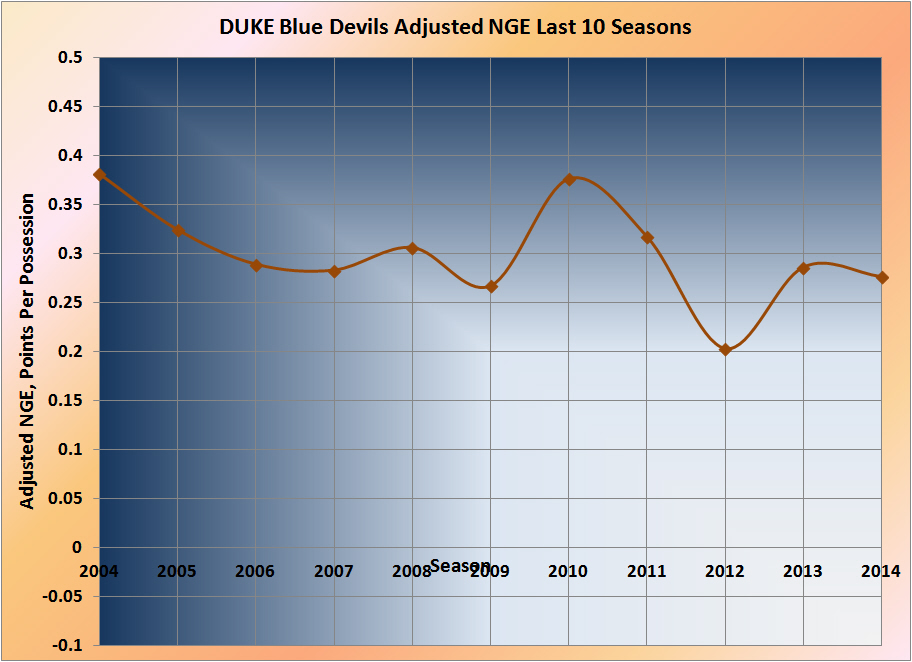
Florida:
Florida does not have the multiple decades of established performance to make it a legitimately elite program from an historical perspective, but since Billy Donovan became the head Gator, the Florida program has consistently been among the nation's best. Over the last 18 years, Florida has claimed 2 National Championships, and in the last 10 years has consistently performed with adjusted Net Game Efficiencies at or above the 0.30 threshold of greatness 4 times. Furthermore, their trend for Adjusted NGE appears rising, after a 3 to 4 year slump following their back-to-back Championships. These factors demand that Florida belongs in today's Championship discussion, even if Florida lacks the history to establish itself as an Elite Program.

Indiana:
Indiana's basketball legacy goes back many decades. The Bob Knight era at IU spanned the 1970s into the 1990s, and during that time, IU was in the conversation most years. When IU and Bob K night parted company, the Hoosiers had been absent the conversation for a few years, and their program slid off the radar almost completely until the Indiana brain trust brought Tom Crean to Bloomington to rebuild the program and return it to national prominence. He is well on his way to succeeding in that primary mission, leading his Hoosiers to the Sweet 16 in 2012 before losing to eventual Champion, Kentucky, and marking that season as one of only 2 teams able to beat the 2012 Kentucky team that season. Indiana has not captured a championship in the last 18 years, and broke the 0.30 ppp threshold for Adjusted NGE only once, in 2012. However, their trend is rising, and for that reason coupled with their rich tradition earns Indiana a spot in this Elite List in 2013.
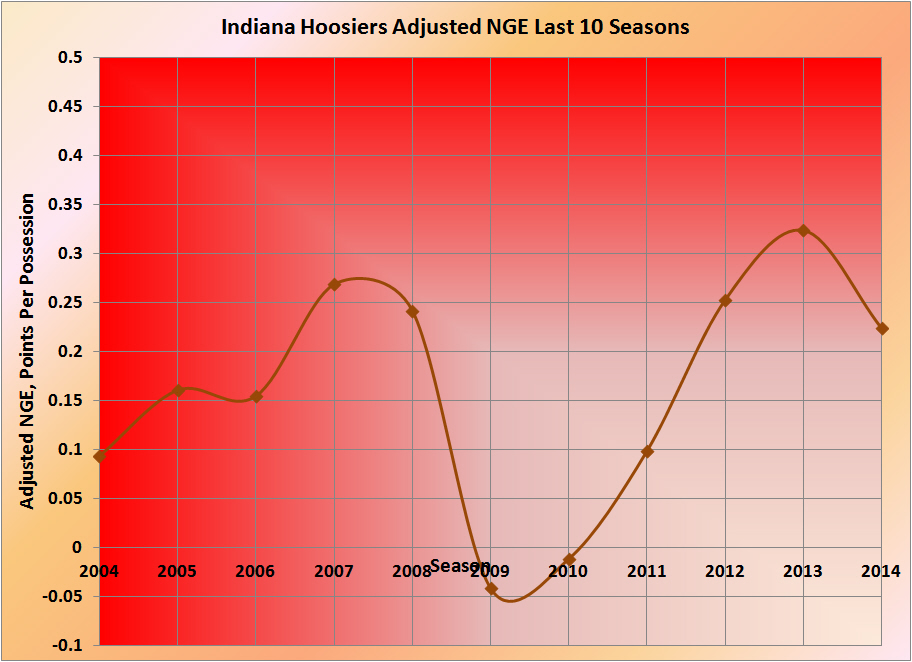
Kansas:
Kansas has one of the richest college basketball traditions of all. It lays claims to Phog Allen, Adolph Rupp, Wilt Chamberlain, and a list of icons of the sport that is truly too long to list here. Their achievements span nearly every decade of the game. In the last 18 years, Kansas has won the Championship. Over the last 10 years, Kansas teams have met or exceeded the 0.30 ppp Adjusted NGE threshold 4 times. There trend is stable at a high level of play. Kansas earns its position on the elite list based on tradition, championships, and performance trends.
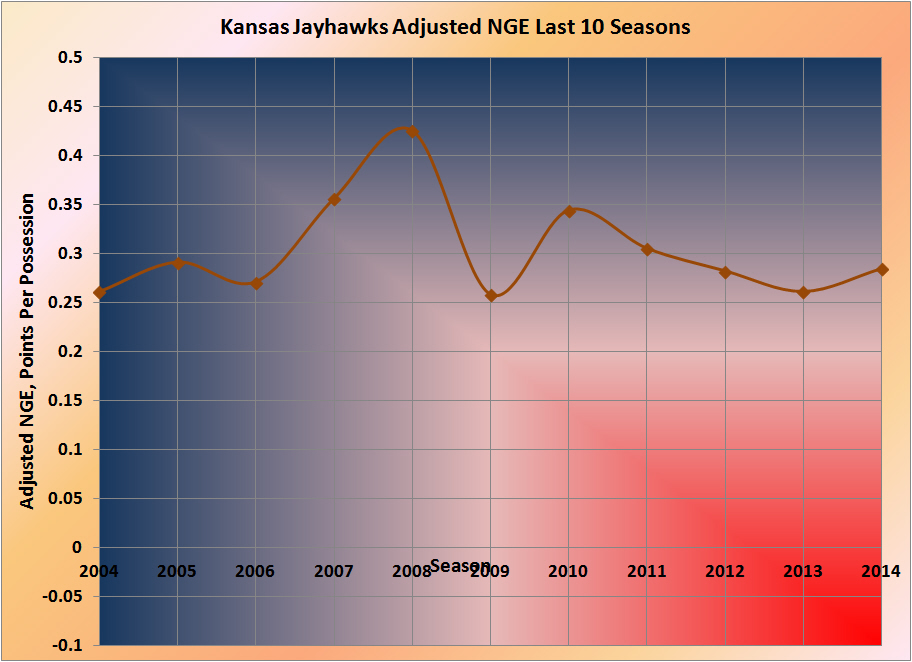
Louisville:
Louisville established itself as a national basketball program during the Denny Crum era that delivered the school their first two championships in the 80s. However, Coach Crum allowed the program to slip back from those levels over the last decade of his tenure before the Cardinals asked Rick Pitino to return to the State of Kentucky are lead their program back into the conversation, which he has clearly done. Over the last 18 years, Louisville has won one championship, last season, and over the last decade their teams have performed at or above the 0.30 ppp Adjusted NGE threshold 3 times. Louisville belongs in the conversation today even though their tradition and history is limited to the last 3 to 4 decades, rather than the last 5 to 6 decades.
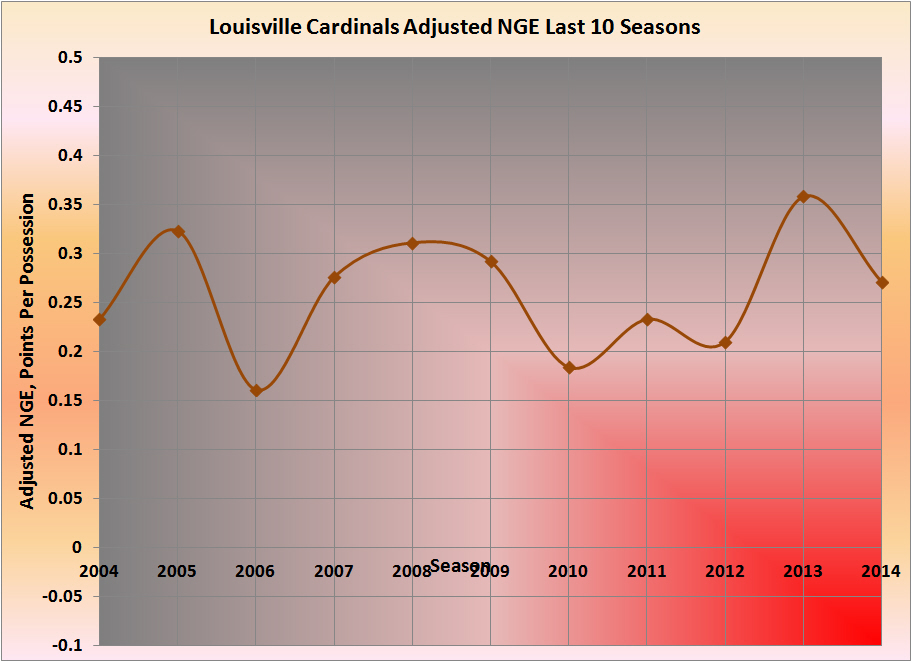
Michigan State:
Michigan State basketball today is defined so much by its current coach, Tom Izzo, but the tradition and history of Michigan State was established on the national stage prior to Coach Izzo's arrival in Lansing. The program has two national championships to its credit, 1979 for Coach Judd Heathcoat with Magic Johnson leading the team, and again with Coach Izzo in 2000. However, over the last decade, Coach Izzo's teams have found a way to be a player in March, and have sustained high levels of play even though the Spartans have only broken the 0.30 ppp threshold one season, 2005. The current trends are sufficient to keep the Spartans in the national conversation as one of the elite programs of the day.
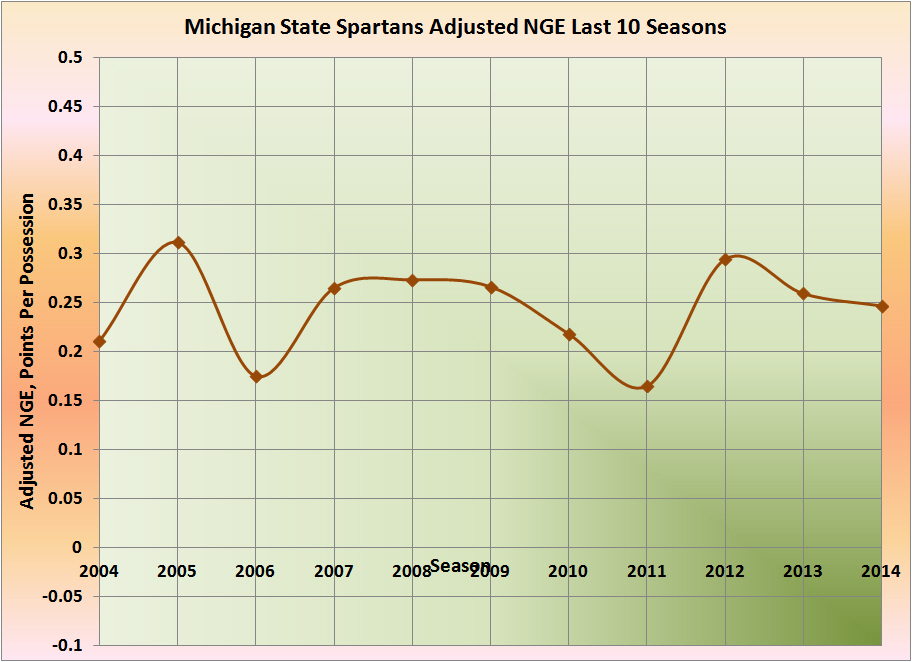
North Carolina:
Coach Dean Smith's tenure at North Carolina was impressive and enduring. However, the UNC basketball story did not begin with Coach Smith, as the Tar Heels prevented Kansas and Wilt Chamberlain from a championship in 1957. Furthermore, the UNC program has continued to write its legacy after Dean Smith passed the torch, and when Roy Williams returned home to lead the Tar Heels, it did not take him long to lead that program to the winner's circle twice. Four times in the last decade, the Tar Heel teams met or exceeded the 0.30 ppp Adjusted NGE threshold. The history alone is sufficient to keep North Carolina in the national conversation. However, the last four seasons have been lean for the Tar Heels, with injuries and early departures to the NBA taking a heavy toll, but Roy Williams continues to keep that program in the forefront and on any reasonable list of elite programs in 2013.

Ohio State:
Ohio State basketball history has a rich tradition and history extending back to the 1960s, and with Thad Matta's arrival in Columbus for the 2005 season, the Buckeyes' basketball fortunes have risen steadily, and remain at a very high level during the summer of 2013. While Ohio State has not claimed a national championship in the last 18 years, it has competed in Final Fours without bringing home the trophy. Three times in Matta's first 9 year, the Buckeyes have performed at or above the 0.30 ppp Adjusted NGE threshhold, and the current trend of performance remains at very high levels while trending upward. Matta has positioned this program such that it must be included in current national championship conversations.
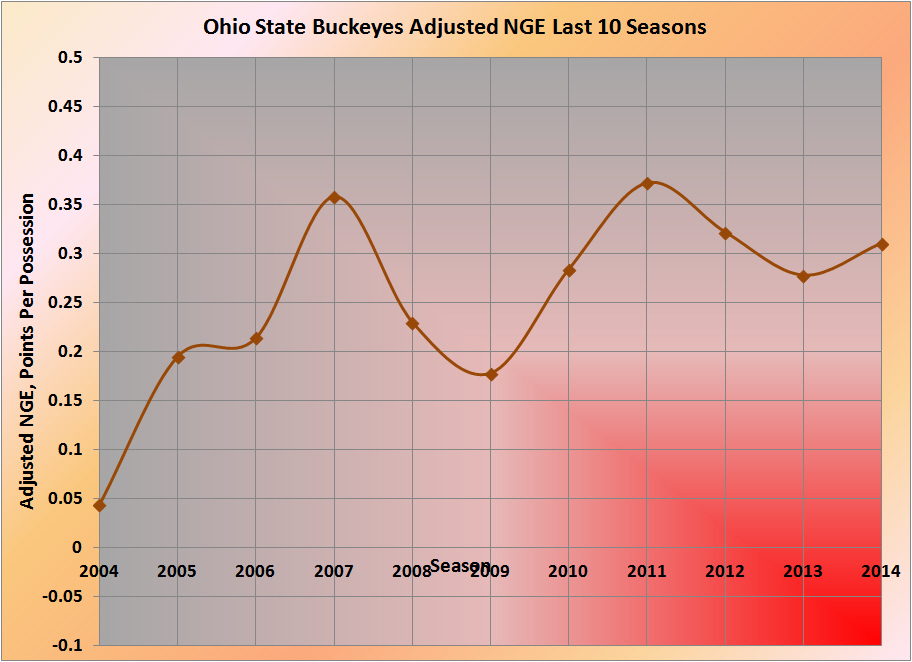
Syracuse:
The 1965 and 1966 Syracuse basketball teams were led by a backcourt of Dave Bing and Jim Boeheim. Dave Bing's run at Syracuse was sufficient to give that program the catalyst of sustained NCAA appearances, culminating in a final four in 1975. However, the Final Four success cost Syracuse its coach, Jim Danforth following the 1976 season, and Syracuse looked to none other than Jim Boeheim to take over the head coaching duties. 2013 concluded Coach Boeheim's 37th year at the Orangemen's coach, a span that has produced 920 wins, one championship (2003), and has seen Syracuse build one of the most consistent performing teams in the game. While Syracuse can't claim a single season in the last 10 with an Adjusted NGE exceeding the 0.30 ppp threshhold, it has been over 0.25 ppp the last 5 years, and its trend is stable for continued high level performance. At least today, Syracuse deserves a place in this conversation. The big unknown for the Syracuse Program will be whether Boeheim's replacement will be able to sustain, or even build upon the success of the last 40 years.

UConn, Arizona, and Maryland Did Not Make the list:
Over the last 18 years, UConn has claimed three NCAA championship trophies (no one has more), and Maryland and Arizona have each taken home the prize once. Yet, these programs are not part of the conversation today, or at least no on my list of top 10 programs as of 2013. The primary reason is their long-term performance, as measured by the Adjusted NGE, simply does not stack up against the 10 that I have discussed.
UConn:
Two 0.30 ppp seasons in the last decade, the last in 2005, and the trend is clearly downward. With Jim Calhoun's exit, and questions about NCAA violations and the academic progress issues confronting the program, it is doubtful that the UConn program will return to the heights that Coach Calhoun established during his tenure. UConn basketball has not tradition or history before Calhoun, and unless it establishes a post -Calhoun record of success, UConn does not belong in the national conversation in 2013.
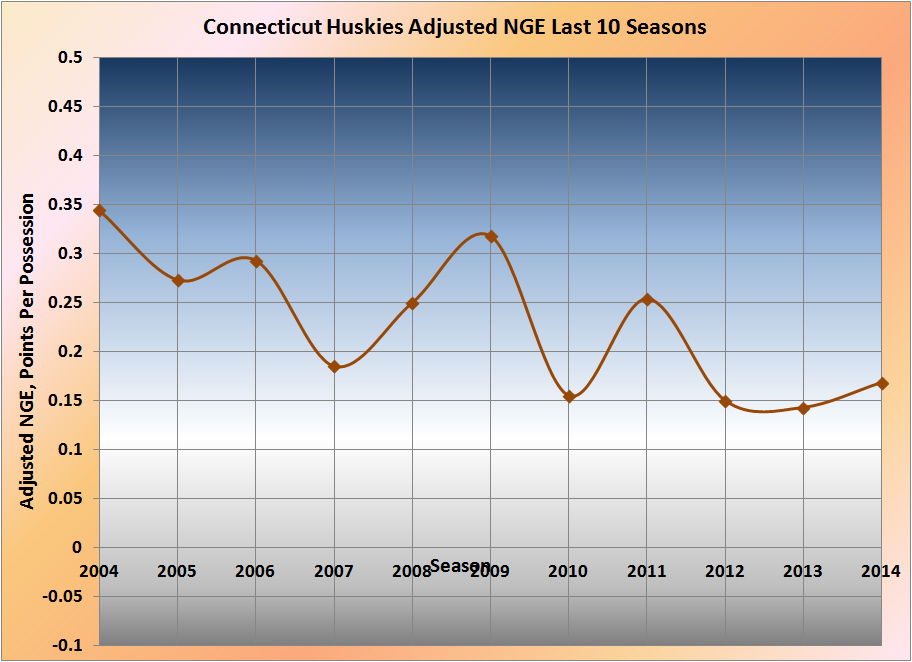
Arizona:
Much like UConn's story is tied to Calhoun, Arizona's story is tied to Lute Olsom. Arizona has had no seasons over 0.30 ppp in the last decade, and if there is a trend upward demonstrated by the last 5 years, it is in a range that is not worthy of national discussion.

Maryland:
Maryland has had no seasons over the 0.30 ppp threshhold in the last decade, and the trend is clearly downward in a range not worthy of note within the Atlantic Coast Conference, much less the national stage.
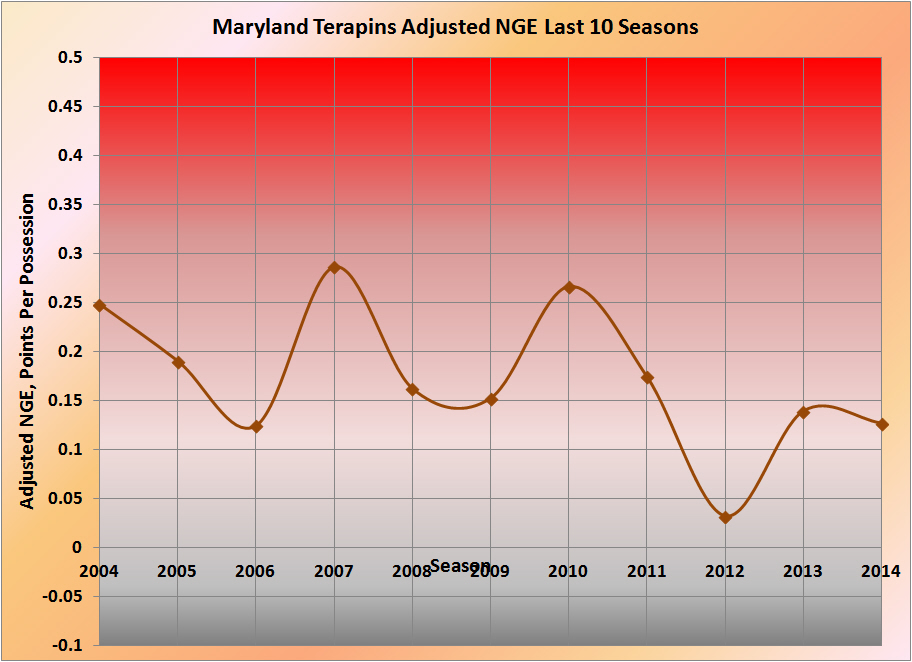
Michigan:
Michigan has a basketball history that spans the 60s (Cazzie Russell), the 80s (A championship) and now a resurgence in the new century under the guidance of John Belein. However, while last season's team posted a very impresasive Adjusted NGE over 0.30 ppp, none of Belein's teams prior to last season, and none of Michigan's teams in the last decade had exceeded 0.20 ppp for a season. The trend is clearly upward under Belein's leadership, but the trend is not strong enough to supplant either Indiana or North Carolina in my opinion. Nevertheless, Michigan remains a team to watch in 2014 and beyond.
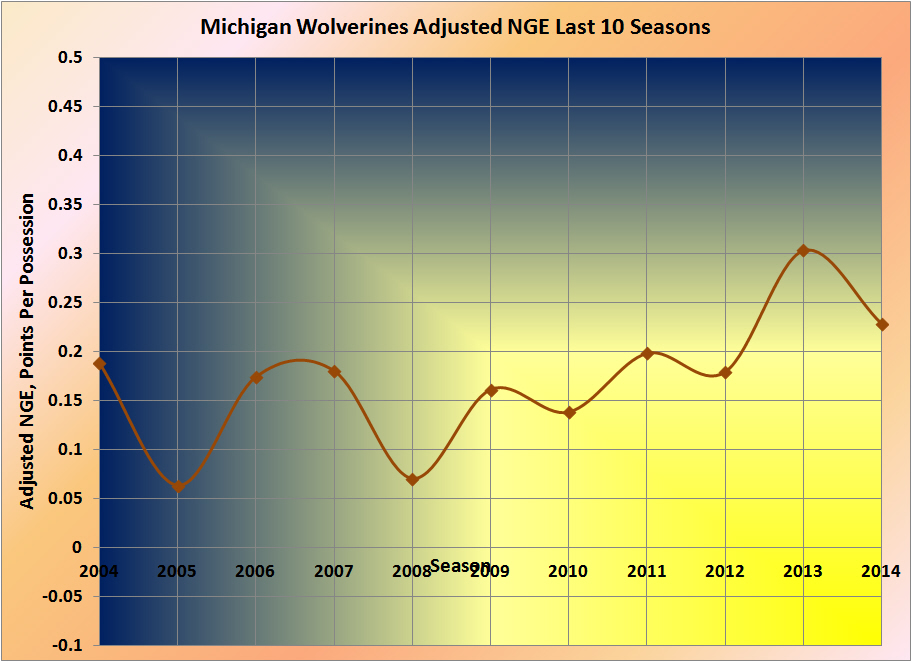
Gonzaga:
Of the programs that did not make the top 10 list, Gonzaga has the strongest argument that it has been wrongly omitted, and is more deserving a spot than either Indiana or North Carolina based on recent performance levels, and trends of performance. However, Gonzaga has no championships, does not have a rich tradition or history spanning decades, has only one season in the last decade near the 0.30 ppp threshhold (2013), and the pattern of the last decade has been marked by peaks every 4 to 5 years, followed by several years of rebuilding and regrouping to reach those national performance levels again.
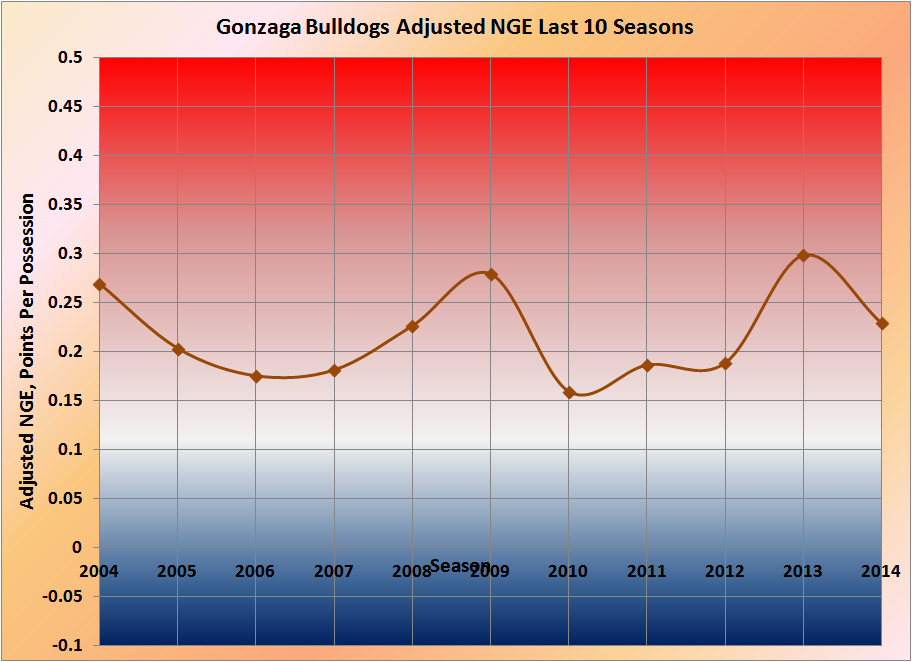
I am sure that my list will create more disagreement than agreement, but let the debate rage on, as no one has the "right" answer to such subjective questions.
Submitted by Richard Cheeks
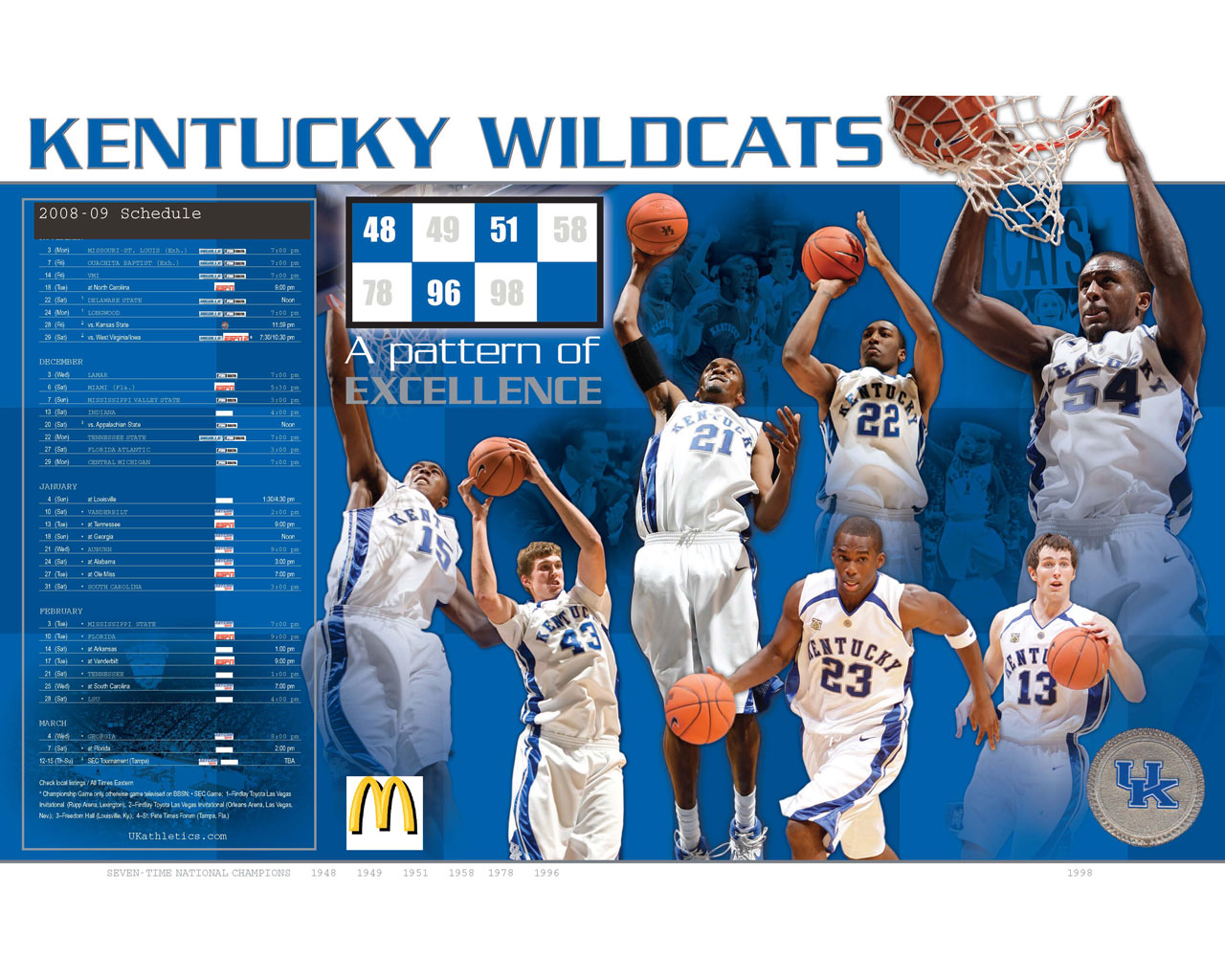

Submitted by Richard Cheeks
![]()
To 2013 v 2014 Roster Comparison
Go Back
To Que Sera Sera-The Future's Not Ours To See (NOT)
Copyright 2013
SugarHill Communications of Kentucky
All Rights Reserved